
This is intended to be a complete list of properties and districts listed on the National Register of Historic Places in Orleans County, New York. The locations of National Register properties and districts may be seen in a map by clicking on "Map of all coordinates". Two listings, the New York State Barge Canal and the Cobblestone Historic District, are further designated a National Historic Landmark.
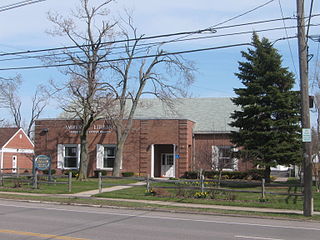
Snyder is a hamlet within the town of Amherst in Erie County, New York, that is part of the Buffalo–Niagara Falls metropolitan area. The hamlet was established in 1837. It was named for Michael Snyder, its first postmaster, who also operated a store at the corner of Harlem Road, which is also known as New York State Route 240, and Main Street, which is also known as New York State Route 5. The hamlet blossomed due to retail activity demand created along the Main Street transportation route between Buffalo and points to the east in the 19th and early 20th century.

Silvermine is an unincorporated community in Fairfield County, Connecticut, United States that extends across three southwestern Connecticut towns: Norwalk, New Canaan and Wilton.
The National Register of Historic Places listings in Syracuse, New York are described below. There are 117 listed properties and districts in the city of Syracuse, including 19 business or public buildings, 13 historic districts, 6 churches, four school or university buildings, three parks, six apartment buildings, and 43 houses. Twenty-nine of the listed houses were designed by architect Ward Wellington Ward; 25 of these were listed as a group in 1996.
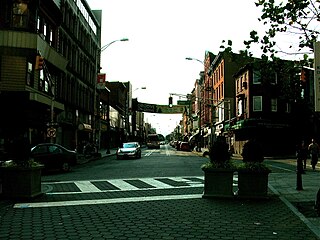
Harsimus is a neighborhood within Downtown Jersey City, Hudson County, in the U.S. state of New Jersey. The neighborhood stretches from the Harsimus Stem Embankment on the north to Christopher Columbus Drive on the south between Coles Street and Grove Street or more broadly, to Marin Boulevard. It borders the neighborhoods of Hamilton Park to the north, Van Vorst Park to the south, the Village to the west, and the Powerhouse Arts District to the east. Newark Avenue has traditionally been its main street. The name is from the Lenape, used by the Hackensack Indians who inhabited the region and could be translated as Crow's Marsh. From many years, the neighborhood was part of the "Horseshoe", a political delineation created by its position between the converging rail lines and political gerrymandering.

Entranceways at Main Street at Lamarck Drive and Smallwood Drive are a set of complementary residential subdivision stone entranceways built in 1926. They are located on Main Street in the hamlet of Snyder, New York within the town of Amherst, which is located in Erie County. These entranceways are markers representing the American suburbanization of rural areas through land development associated with transportation on the edges of urban developments. The Smallwood entranceway is a pair of symmetric groupings of stone gatehouses and posts flanking the two sides of the drive at Main Street. The Lamarck entranceway is a pair of Y-shaped and U-shaped stone half-walls flanking the two sides of the drive at Main Street. The entranceways were added to the National Register of Historic Places on December 7, 2005.

Entranceway at Main Street at Roycroft Boulevard is a suburban residential subdivision entranceway built in 1918. It is on Main Street in the hamlet of Snyder, New York, in the town of Amherst within Erie County. The entranceway is a marker that represents the American suburbanization of rural areas, suburbanization that occurred through transportation-related land development on the edges of urban areas. It consists of a variety of half-height wall formations, featuring a semicircular wall on the Roycroft Boulevard median's intersection with Main Street. The entranceway was added to the National Register of Historic Places on December 7, 2005.
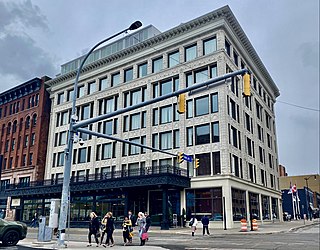
The Harlow C. Curtiss Building, is a historic building located at Buffalo in Erie County, New York. Originally built for office use, the building was named for its owner Harlow Clarke Curtiss, a prominent Buffalo attorney and real estate investor. The building design resembles elements of the works of renowned Chicago architects such as Daniel Burnham and Louis Sullivan, both of whom also designed buildings in Buffalo.
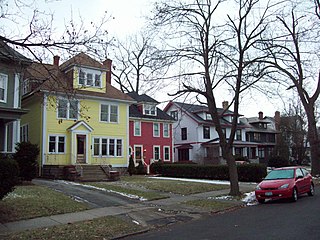
Parkside East Historic District is a national historic district located at Buffalo in Erie County, New York. The district is architecturally and historically significant for its association with the 1876 Parks and Parkways Plan for the city of Buffalo developed by Frederick Law Olmsted. It consists of 1,769 contributing structures developed from 1876 to 1936, as a middle class residential neighborhood. The district largely contains single-family dwellings, built in a variety of popular architectural styles, and located along the irregular and curvilinear street pattern developed by Olmsted. The district is located to the east of Buffalo's Delaware Park and includes the Walter V. Davidson House and the separately listed Darwin D. Martin House, both designed by Frank Lloyd Wright.

There are 75 properties listed on the National Register of Historic Places in Albany, New York, United States. Six are additionally designated as National Historic Landmarks (NHLs), the most of any city in the state after New York City. Another 14 are historic districts, for which 20 of the listings are also contributing properties. Two properties, both buildings, that had been listed in the past but have since been demolished have been delisted; one building that is also no longer extant remains listed.

Canandaigua Historic District is a national historic district located at Canandaigua in Ontario County, New York. The district includes 354 residential, commercial, religious, and civic properties that constitute the historic core of Canandaigua. It incorporates the North Main Street Historic District. The structures date from the 1810s to 1930s and contains a number of distinctive buildings reflecting a variety of architectural styles including Greek Revival, Italianate, Colonial Revival. The Ontario County Courthouse is located within the district boundaries. Located in the district is the separately listed former United States Post Office.

Rochester Savings Bank is a historic bank building located at Rochester in Monroe County, New York. It is a four-story, V-shaped structure, sheathed in Kato stone from Minnesota. It was designed by McKim, Mead and White and built in 1927 to house the Rochester Savings Bank. The building's banking room interior features murals painted by noted artist Ezra Winter.

This is intended to be a complete list of properties and districts listed on the National Register of Historic Places in Rochester, New York, United States. The locations of National Register properties and districts may be seen in an online map by clicking on "Map of all coordinates".
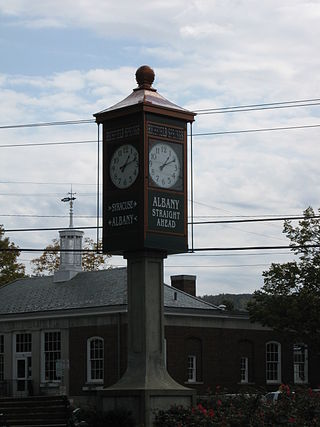
East Main Street Historic District is a national historic district located at Richfield Springs in Otsego County, New York. It encompasses 57 contributing buildings, one contributing site, eight contributing structures, and one contributing object. The body of the district includes 33 historic residences, two historic boarding houses, a theatre, post office, a former hotel, and a church. Spring Park includes a contributing post clock (1918), set of semi-circular limestone steps, bandstand (1904), and cobblestone fountain (1931). Located within the district boundaries is the U.S. Post Office building.
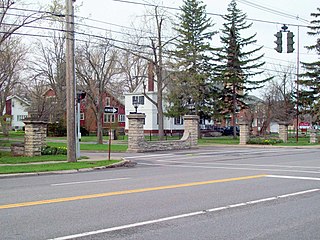
Entranceway at Main Street at High Park Boulevard is a suburban residential subdivision entranceway built about 1916 by developer Charles S. Burkhardt. It is located on Main Street at Eggertsville in the town of Amherst within Erie County. It consists of tall and short stone posts, corresponding quarter-height stone walls, and accent light fixtures set on either side of the streets' intersecting corners.

Entranceway at Main Street at Lafayette Boulevard is a suburban residential subdivision entranceway built about 1920 by Orange & Black Corp., Developers. It is located on Main Street in the town of Amherst within Erie County. It consists of roofed stone archways, connecting half-height stone walls, and stone posts located on either corner.

Entranceway at Main Street at LeBrun Road is a suburban residential subdivision entranceway in Amherst, New York, USA. It was built about 1920 by Goode & Sickels, Realtors. It is located on Main Street at Eggertsville in the town of Amherst within Erie County. It consists of half-height brick masonry walls, brick masonry posts, and accent light fixtures located on either street corner.

Entranceway at Main Street at Westfield Road and Ivyhurst Road is a suburban residential subdivision entranceway built about 1920 by John Sattler. It is located on Main Street in the town of Amherst within Erie County. It consists of stone posts, connecting quarter-height stone walls, and accent light fixtures located on either street corner.

Bryant Fleming House is a historic home located at Wyoming in Wyoming County, New York. It was built about 1850 and is a 1+1⁄2-story, two-by-three-bay cross-gabled vernacular Italianate-style cottage with a two-by-three-bay, 1-story rear wing. Another main building is a multi-purpose "playhouse" designed for large-scale entertaining and accommodation of overnight guests. The property includes notable landscape features that its principal owner, Bryant Fleming (1877–1946) designed and installed after he purchased the property about 1910. Also on the property is a small decorative pool with fountain, two sets of stone and concrete steps, a garden gate, and brick walls with gate posts.

The U.S. Post Office and Courthouse-Littleton Main, now serving exclusively as the Littleton Main Post Office, is a historic federal building at 134 Main Street in Littleton, New Hampshire. Built in 1933, it is one of the more architecturally sophisticated and imposing federal buildings built in New Hampshire in the 20th century. The building was listed on the National Register of Historic Places in 1986.























